For the purpose of this subchapter, the following definitions shall apply unless the context clearly indicates or requires a different meaning.
AWNING. Any roof-like structure made of cloth, metal or other material attached to a building and erected over a window, doorway and the like in such a manner as to permit its being raised or retracted to a position against the building when not in use.
AWNING, CANOPY OR MARQUEE SIGN. A Sign that is mounted on, painted on, or attached to, an awning, canopy or marquee. No such signs shall project above, below or beyond the awning, canopy or marquee unless otherwise permitted in the Downtown District.
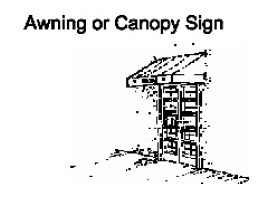
BEACON LIGHT. A light used primarily to attract attention to a location, whether moving or stationary, other than when required by law to meet applicable safety requirements.
BILLBOARD. Any temporary or permanent sign or sign face used for placing messages or authorizing others to place messages in exchange for rent or other consideration. Tenant identification and development identification signs shall not be considered BILLBOARDS solely because the use of the sign area may be included as a right associated with lease of the tenant or development space giving rise to such authorized sign.
CANOPY. A roof-like structure similar to an awning; except that, it cannot be raised or retracted to a position against the building.
COMMERCIAL SIGN. Any sign wording, logo or other representation that, directly or indirectly, names, advertises or otherwise calls attention to a business product, service, idea or commercial activity.
DOUBLE-FACED SIGN. Include those signs where the sign faces are parallel or where the interior angle formed by the faces of a V-shaped sign is 60 degrees or less.
EAVE LINE. A line following the part of the roof that extends beyond the exterior side wall, generally located on the projecting lower edge of a roof where the gutters may be located.
ESTABLISHMENT. Either of the following:
(1) An institutional, business, commercial or industrial activity that is the sole occupant of one or more buildings; or
(2) An institutional, business, commercial or industrial activity that occupies a portion of a building, and the activity is a logical and separate entity from the other activities within the building and not a department of the whole, and the activity has either a separate entrance from the exterior of the building, or a separate entrance from a common and clearly defined entryway that has direct access to the exterior of the building.
FREESTANDING SIGN. A sign on a non-residential zoning lot supported by one or more uprights, poles or braces or foundation in or upon the ground in a permanent manner, but not including pole signs.
FRONTAGE. The lineal extent of a zoning lot abutting a street or public roadway, or the lineal extent of a zoning lot abutting a public parking area if such lot has no street frontage.
INTEGRAL ROOF SIGN.
(1) Any sign erected or constructed as an integral part of a normal roof structure of any design, such that no part of the sign:
(a) Extends vertically above the highest portion of the roof; and
(b) Is separated from the rest of the roof by a space of more than six inches.
(2) No integral portion of a roof shall extend more than five feet above the structural roof.
MARQUEE. Any canopy that is made of durable materials and is a permanent fixture of the building to which it is attached.
MESSAGE. A communication of identification or advertising information visually perceived. Said communication may consist of words, abbreviations, numbers, symbols, pictures, geometric shapes and the like.
MONUMENT SIGN. A type of freestanding sign placed upon, or supported by, the ground, independent of the principal structure on the lot, presenting a monolithic structure.
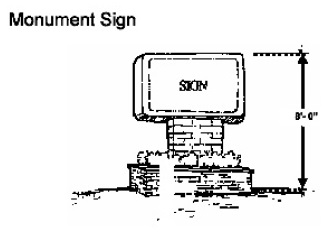
NON-RESIDENTIAL USE. Any commercial, office or religious use lawfully occurring on the applicable zoning lot as the primary use in a zoning district authorizing such use. NON-RESIDENTIAL USES shall not include:
(1) Zoning lots containing agricultural uses within a residential or agricultural zoning district; and
(2) Lots with no current use, including vacant or undeveloped properties and structures, except as pertaining to temporary construction and development signs authorized herein for a use pending construction or development.
NON-RESIDENTIAL ZONING LOT. A zoning lot containing a non-residential use.
POLE SIGN or ELEVATED SIGN. Any sign placed upon, or supported by, the ground independent of the principal structure on the zoning lot where the bottom edge of the sign is ten feet or more above the ground level.
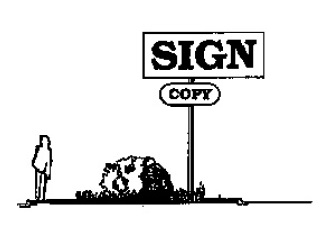
PORTABLE SIGN. Any sign not permanently attached to the ground or other permanent structure; any movable display structure capable of relocation, whether under its own power or towed by a motor vehicle; signs designed to be transported by means of wheels or skids; signs converted to A- or T-frames, menu and sandwich board signs; and signs attached to or painted on vehicles parked and visible from the public right-of-way, unless said vehicle is used in the normal day-to-day operations of a business. The display message of the sign may be painted or non-painted and capable of being readily altered and may be with or without electrical illumination and power, and with or without wheels.
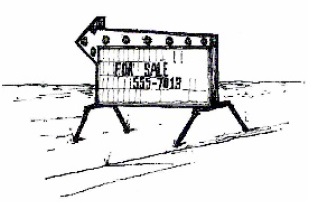
PROJECTING SIGN. Any sign that is supported by any exterior wall of a building or suspended beneath any awning, canopy or marquee with the exposed face of said sign in a plane approximately perpendicular to the plane of the wall and the like, and projecting more than 18 inches from the structure.
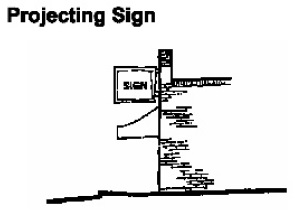
RESIDENTIAL ZONING LOT. All zoning lots except those containing a non-residential use.
SANDWICH BOARD SIGN. An A-frame sign that stands with self-supporting elements and is not permanently affixed to the ground.
SEARCHLIGHT. An apparatus containing a light source and a reflector for projecting a high-intensity beam of approximately parallel rays of light.
SIGN. Any object, device, display, structure or surface, or part thereof, that is used to advertise, identify, display or attract attention to any object, person, institution, organization, business, project, service or event by any means, including words, letters, figures, designs, symbols, fixtures, colors or illumination for signage.
SIGN AREA. The area of the one imaginary square or rectangle that would completely enclose all parts of a sign, including the background.
SIGN AREA ALLOWANCE. The total of the sign areas of all signs that a particular establishment is permitted to display under the terms of this subchapter.
SIGN PERMIT. A permit issued by the Director to regulate the erection, expansion, alteration, relocation or reconstruction of signs in all parts of the city.
STREET FRONTAGE. See FRONTAGE.
TEMPORARY SIGN. A sign not constructed or intended for long term or permanent use.
VACANT PROPERTY. A zoning lot with no current lawful building occupancy and use.
V-SHAPED SIGN. Freestanding signs erected upon common or separate structures that present a V-shape appearance.
WALL SIGN. Any sign attached to or erected against any wall, awning, canopy or marquee with the exposed face of said sign in a place approximately parallel to the plane of the wall and the like and not projecting out more than 18 inches.

WINDOW SIGN. Any sign, picture, symbol or combination thereof, designed to communicate information about an activity, business, commodity, event, sale or service that is visible from the exterior of a building and is painted on, affixed to or suspended immediately behind a window.
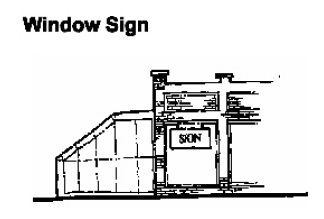
ZONING LOT. The parcel or parcels of land associated with the use or improvements on it. Common area for any multi-lot development shall not be deemed a separate ZONING LOT authorizing any additional signs, except as may be directly authorized by the city relating to such common ground use. Where multiple establishments are contained within a single development, the entire development parcel or subdivision shall constitute the ZONING LOT regardless of the existence of subdivided parcels within such development.
(Ord. 623, passed 9-8-1970; Ord. 3786, passed 12-17-2012)